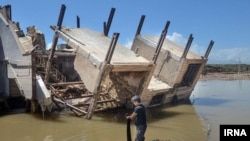A new round of torrential rains are expected across nine Iranian provinces during the coming weekend while flood-hit areas in Iran, particularly Lorestan Province, have suffered heavy damages and losses during the past two weeks with the casualty toll reaching 67 and rising.
The Iranian Meteorological Organization has predicted between 10 to 35 mm of rain in Kermanshah, Ilam, Khouzestan, Kohkiloyeh and Boyer Ahmad, Bushehr and north of Fars province, and as much as 30 to 50 mm in Khorasan and Semnan provinces during Saturday and Sunday. The new wave of rainfall will start Friday evening, April 5.
In the meantime, EU has vowed to provide €1.2 million in emergency support to help flood victims in Iran.
The European Commission announced an initial amount of €1.2 million in response to the devastating floods that have recently affected northern and south-western parts of Iran. The emergency funding will assist the most vulnerable communities, said the EC.
Iran's Interior Minister Abdolreza Rahmani Fazli confirmed during a visit to the town of Pol Dokhtar in Lorestan province on Friday that Lorestan is the worst hit area in the floods that affected 28 of 31 Iranian provinces during the past two weeks.
He said that most of the damages have been made to roads and bridges in this province.
Assad Abdollahi, the local governor of the province's capital city Khorramabad said on Friday that floods have blocked access to 132 villages in the province, while 12 villages have no longer access to drinking water, and power cuts have affected 27 other villages.
Meanwhile, 3,000 troops are dredging the streets in the mud-covered city of Khorramabad, said reports from the city.
There have been a lot of criticism about late and insufficient relief efforts, and regarding the chaos in distribution of aid in flood-hit areas.
Iranian state TV's presenters have been criticizing government officials for the chaos, while the officials have occasionally tried to defend their performance.
Iranian Red Crescent Society Chief Ali Asghar Peyvandi complained about "irregularities and insecurity" as hinderance to fair distribution of aid, while Interior Minister Rahmani Fazli said that "the first stage involving confronting floods has been dealt with properly and now it is time to render services such as providing temporary housing and distributing food and medical supplies to the communities in the affected areas."
Fazli's comment that the actual floods have been dealt with "properly" is a very controversial statement given widespread criticism of lack of preparedness by the government, wrong construction decisions in past years leading to flash floods and deftness to the disaster by senior officials in the first week of floods.
Meanwhile, officials in Khuzstan province have warned citizens about fresh floods within the next hours in the town of Gourieh. However, the Crisis Management Chief in the province said flood water has still not reached the town, adding that that armed forces are prepared to prevent the flow of water into the town by controlled explosions in a nearby sugar cane irrigation canal.
In Golestan province in the north, where floods started two weeks ago, fresh rainfalls have led to a 30 cm rise in the water level in the city of Aq Qala. The local governor in the area attributed new floods to the melting of snow on the highlands.
There are conflicting unofficial reports on the casualty tolls, but the coroner's office put the toll at 67 people by Friday afternoon.
Chief Coroner Ahmad Shojaee told Fars News Agency on Friday that the casualty toll includes 21 deaths in Fars province, 15 in Lorestan, 8 in Golestan, 6 in Mazandaran, 5 in Hamadan, 3 in northern Khorassan, 2 on the Rasht-Qazvin road, 2 in Kohkiloyeh and Boyer Ahmad, and one in Khouzestan, Kermanshah, Semnan, Qom and Khorasan Razavi each.
At the same time, according to the Iranian Labor News Agency (ILNA), water level in many Iranian lakes and wetlands has risen up to 100 percent.
An infographic published by the official news agency IRNA indicates that the amount of water in Lake Urmia in the northwest has surpassed 3 billion cubic meters, and the water level in the lake has risen by 42 cm. This comes while Lake Urmia has been drying out during the past decade.





